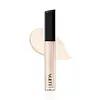What's inside
What's inside
 Key Ingredients
Key Ingredients

 Benefits
Benefits

 Concerns
Concerns

 Ingredients Side-by-side
Ingredients Side-by-side

Caprylic/Capric Triglyceride
MaskingTitanium Dioxide
Cosmetic ColorantPolyisobutene
Phytosteryl/Isostearyl/Cetyl/Stearyl/Behenyl Dimer Dilinoleate
Skin ConditioningDiisostearyl Malate
EmollientDipentaerythrityl Hexahydroxystearate/Hexastearate/Hexarosinate
Skin ConditioningIsodecyl Neopentanoate
EmollientSynthetic Wax
AbrasiveMica
Cosmetic ColorantMethyl Methacrylate Crosspolymer
Tocopheryl Acetate
AntioxidantSynthetic Fluorphlogopite
Microcrystalline Wax
Emulsion StabilisingBisabolol
MaskingAluminum Hydroxide
EmollientSorbitan Sesquioleate
EmulsifyingTocopherol
AntioxidantPolyglyceryl-6 Polyricinoleate
EmulsifyingDimethicone
EmollientPropylene Glycol Dicaprylate/Dicaprate
EmollientPolyhydroxystearic Acid
EmulsifyingLecithin
EmollientIsostearic Acid
CleansingIsopropyl Myristate
EmollientEthylhexyl Palmitate
EmollientPolyglyceryl-3 Polyricinoleate
EmulsifyingHydrogenated Castor Oil
EmollientDehydroacetic Acid
PreservativeCI 77491
Cosmetic ColorantCaprylic/Capric Triglyceride, Titanium Dioxide, Polyisobutene, Phytosteryl/Isostearyl/Cetyl/Stearyl/Behenyl Dimer Dilinoleate, Diisostearyl Malate, Dipentaerythrityl Hexahydroxystearate/Hexastearate/Hexarosinate, Isodecyl Neopentanoate, Synthetic Wax, Mica, Methyl Methacrylate Crosspolymer, Tocopheryl Acetate, Synthetic Fluorphlogopite, Microcrystalline Wax, Bisabolol, Aluminum Hydroxide, Sorbitan Sesquioleate, Tocopherol, Polyglyceryl-6 Polyricinoleate, Dimethicone, Propylene Glycol Dicaprylate/Dicaprate, Polyhydroxystearic Acid, Lecithin, Isostearic Acid, Isopropyl Myristate, Ethylhexyl Palmitate, Polyglyceryl-3 Polyricinoleate, Hydrogenated Castor Oil, Dehydroacetic Acid, CI 77491
Water
Skin ConditioningTitanium Dioxide
Cosmetic ColorantCyclopentasiloxane
EmollientPhenyl Trimethicone
Skin ConditioningTalc
AbrasiveButylene Glycol
HumectantCetyl PEG/PPG-10/1 Dimethicone
EmulsifyingPvp
Emulsion StabilisingCI 77492
Cosmetic ColorantPEG-10 Dimethicone
Skin ConditioningDisteardimonium Hectorite
StabilisingVinyl Dimethicone/Methicone Silsesquioxane Crosspolymer
Sodium Chloride
MaskingAluminum Hydroxide
EmollientTriethoxycaprylylsilane
CI 77491
Cosmetic ColorantStearic Acid
CleansingCI 77499
Cosmetic ColorantChlorphenesin
AntimicrobialMethylparaben
PreservativeDimethicone
EmollientButylparaben
MaskingTocopheryl Acetate
AntioxidantHippophae Rhamnoides Fruit Extract
Skin ConditioningCentella Asiatica Extract
CleansingPortulaca Oleracea Extract
Skin ConditioningVitex Agnus-Castus Extract
AstringentAnthemis Nobilis Flower Extract
MaskingParfum
MaskingLinalool
PerfumingLimonene
PerfumingButylphenyl Methylpropional
PerfumingHexyl Cinnamal
PerfumingAlpha-Isomethyl Ionone
PerfumingGeraniol
PerfumingCitronellol
PerfumingCitral
PerfumingBenzyl Alcohol
PerfumingIsoeugenol
PerfumingBenzyl Salicylate
PerfumingWater, Titanium Dioxide, Cyclopentasiloxane, Phenyl Trimethicone, Talc, Butylene Glycol, Cetyl PEG/PPG-10/1 Dimethicone, Pvp, CI 77492, PEG-10 Dimethicone, Disteardimonium Hectorite, Vinyl Dimethicone/Methicone Silsesquioxane Crosspolymer, Sodium Chloride, Aluminum Hydroxide, Triethoxycaprylylsilane, CI 77491, Stearic Acid, CI 77499, Chlorphenesin, Methylparaben, Dimethicone, Butylparaben, Tocopheryl Acetate, Hippophae Rhamnoides Fruit Extract, Centella Asiatica Extract, Portulaca Oleracea Extract, Vitex Agnus-Castus Extract, Anthemis Nobilis Flower Extract, Parfum, Linalool, Limonene, Butylphenyl Methylpropional, Hexyl Cinnamal, Alpha-Isomethyl Ionone, Geraniol, Citronellol, Citral, Benzyl Alcohol, Isoeugenol, Benzyl Salicylate
 Reviews
Reviews

Ingredients Explained
These ingredients are found in both products.
Ingredients higher up in an ingredient list are typically present in a larger amount.
Aluminum Hydroxide is a form of aluminum. It can be naturally found in nature as the mineral gibbsite. In cosmetics, Aluminum Hydroxide is used as a colorant, pH adjuster, and absorbent.
As a colorant, Aluminum Hydroxide may add opacity, or reduce the transparency. Aluminum hydroxide is contains both basic and acidic properties.
According to manufacturers, this ingredient is an emollient and humectant. This means it helps hydrate the skin.
In medicine, this ingredient is used to help relieve heartburn and help heal ulcers.
There is currently no credible scientific evidence linking aluminum hydroxide in cosmetics to increased cancer risk.
Major health organizations allow the use of aluminum hydroxide in personal care products and have not flagged it as a carcinogenic risk at typical usage levels.
Learn more about Aluminum HydroxideCi 77491 is also hydrated iron III oxide. It's sole purpose is to give a red/pink hue to products.
Iron III oxides are classified as inorganic chemicals for coloring.
Synthetically created Ci 77491 is considered safer than those naturally found. This is because the synthetically created version may contain less impurities. Iron oxides are generally non-toxic and non-allergenic.
Learn more about CI 77491Dimethicone is a type of synthetic silicone created from natural materials such as quartz.
What it does:
Dimethicone comes in different viscosities:
Depending on the viscosity, dimethicone has different properties.
Ingredients lists don't always show which type is used, so we recommend reaching out to the brand if you have questions about the viscosity.
This ingredient is unlikely to cause irritation because it does not get absorbed into skin. However, people with silicone allergies should be careful about using this ingredient.
Note: Dimethicone may contribute to pilling. This is because it is not oil or water soluble, so pilling may occur when layered with products. When mixed with heavy oils in a formula, the outcome is also quite greasy.
Learn more about DimethiconeTitanium dioxide is a mineral UV filter widely used in sunscreens and cosmetics.
It is one of only two UV filters officially classified as “mineral” by regulatory agencies, the other being zinc oxide.
Titanium dioxide provides broad-spectrum protection mostly in the UVB and UVAII range, with some protection in the UVAI range.
While its UVA protection isn’t as strong as zinc oxide’s, the difference is minor.
A common myth is that mineral UV filters reflect UV light. However, modern research shows titanium dioxide absorbs UV radiation like chemical filters (~95% absorption & 5% reflection).
Thanks to its non-irritating nature, titanium dioxide is suitable for sensitive, acne-prone, or redness-prone skin. It is unlikely to cause "eye sting" like other sunscreen ingredients.
A major drawback of this ingredient is its white cast and thick texture. This is why mineral sunscreens often leave a white cast and are less cosmetically elegant than chemical/hybrid sunscreens.
To improve white cast and spreadability, micronized or nano-sized titanium dioxide is often used.
There are ongoing concerns surrounding nano-titanium oxide's impact on marine ecosystems.
There is no conclusive evidence that any form of titanium oxide (or any other sunscreen ingredients) will cause harm to marine ecosystems or coral reefs. The science is still developing but many consumers are keeping a close eye on this issue.
Please note, many destinations have reef-safety sunscreen rules. For instance, the U.S. Virgin Islands advises all visitors to use non-nano mineral sunscreens.
Nano mineral sunscreens once raised safety concerns about absorption into skin.
Extensive research has shown that they do not penetrate healthy or damaged skin; they remain safely on the surface and the top layer of dead skin (stratum corneum).
You'll likely find titanium dioxide bundled with alumina, silica, or dimethicone. These ingredients help make titanium dioxide highly photostable; this prevents it from interacting with other formula components under UV light.
Learn more about Titanium DioxideTocopheryl Acetate is AKA Vitamin E. It is an antioxidant and protects your skin from free radicals. Free radicals damage the skin by breaking down collagen.
One study found using Tocopheryl Acetate with Vitamin C decreased the number of sunburned cells.
Tocopheryl Acetate is commonly found in both skincare and dietary supplements.
Learn more about Tocopheryl Acetate